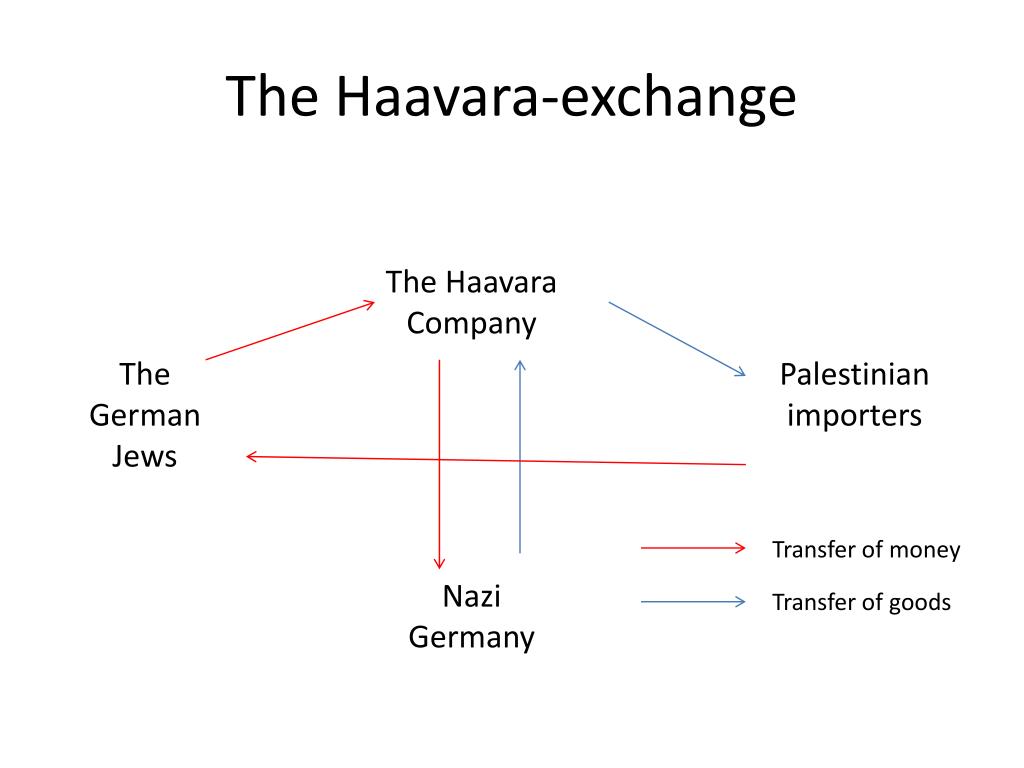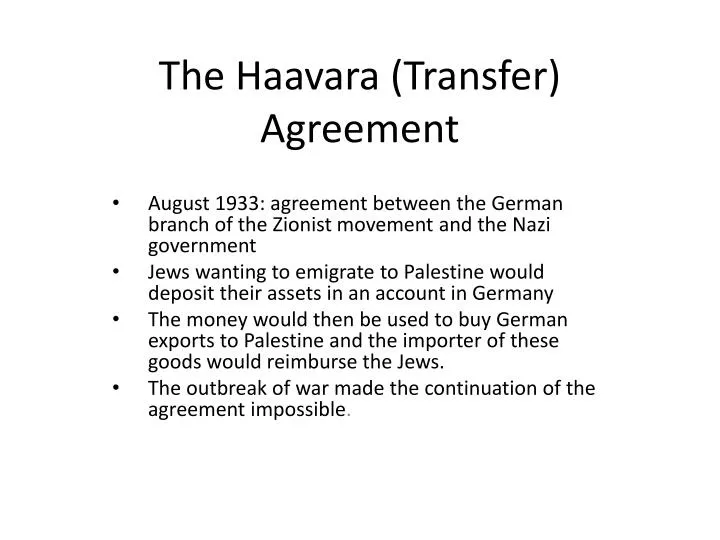The Haavara Agreement: A Controversial Pact
Could a pact forged in the shadow of rising tyranny offer a lifeline to the persecuted? The Haavara Agreement, a controversial deal struck between Nazi Germany and Zionist organizations in 1933, aimed to facilitate the emigration of German Jews to Palestine, transferring some of their assets in the process. This agreement, born of desperation and fraught with ethical dilemmas, remains a chilling reminder of the impossible choices faced by those caught in the grip of history's darkest chapter.
The year was 1933. Adolf Hitler's grip on Germany tightened, and the persecution of Jews intensified. Amid the escalating terror, a seemingly improbable agreement emerged the Haavara Agreement. This pact, finalized on August 7, 1933, allowed German Jews to transfer a portion of their assets to Palestine, then under British Mandate, in exchange for purchasing German goods. It was a complex and morally ambiguous arrangement, born out of the urgent need to rescue Jews from the Nazi regime while navigating the treacherous political landscape of the time. The agreement was not without its critics, both within the Jewish community and the Nazi party itself. Some Jews viewed it as collaboration with the enemy, while some Nazi officials saw it as an obstacle to their goal of total Jewish dispossession. Nevertheless, the Haavara Agreement facilitated the emigration of approximately 60,000 German Jews to Palestine between 1933 and 1939, providing a lifeline at a time when escape routes were rapidly closing.
| Name: | The Transfer Agreement (Haavara Agreement) |
| Date Signed: | August 7, 1933 |
| Parties Involved: | Nazi Germany and Zionist Organizations (primarily the Zionist Federation of Germany and the Anglo-Palestine Bank) |
| Purpose: | To facilitate the emigration of German Jews to Palestine and allow them to transfer some of their assets. |
| Mechanism: | German Jews deposited funds into a special account in Germany. These funds were used to purchase German goods, which were then exported to Palestine. The proceeds from the sale of these goods in Palestine were then transferred to the Jewish emigrants. |
| Controversy: | The agreement was highly controversial, criticized by many Jews as collaboration with the Nazis and by some Nazis who opposed any concessions to Jews. |
| Impact: | Facilitated the emigration of approximately 60,000 German Jews to Palestine between 1933 and 1939. |
| Termination: | The agreement was terminated in September 1939 with the outbreak of World War II. |
| Reference: | United States Holocaust Memorial Museum |
The Haavara Agreement was born out of a confluence of desperate circumstances. For German Jews, it offered a rare opportunity to escape the tightening noose of Nazi persecution. For the Zionist movement, it represented a chance to bolster the Jewish population in Palestine, furthering their goal of establishing a Jewish state. And for the Nazi regime, it provided a means of ridding Germany of its Jewish population while simultaneously boosting German exports and circumventing the international boycott of German goods. The agreement involved a complex financial mechanism. Jewish emigrants deposited Reichsmarks into a German bank account. These funds were then used to purchase German manufactured goods, which were shipped to Palestine. Upon arrival, the goods were sold, and the proceeds were distributed to the emigrants in Palestine pounds. This convoluted process ensured that the Nazis received valuable foreign currency, while the emigrants salvaged a fraction of their assets.
The ethical implications of the Haavara Agreement were, and remain, deeply troubling. Critics argued that by engaging in economic transactions with the Nazi regime, the Zionist movement was effectively providing financial support to a regime committed to their destruction. The debate raged within the Jewish community, with prominent figures like Rabbi Stephen Wise vehemently opposing the agreement. Within the Nazi party itself, there was also dissent. Hardline antisemites viewed the agreement as an unacceptable concession to the Jews, hindering their ultimate goal of complete extermination. The Haavara Agreement operated for six years, until the outbreak of World War II in September 1939. During this period, it became a lightning rod for controversy, highlighting the agonizing choices faced by those caught between the need for survival and the dictates of conscience. The agreement ultimately facilitated the emigration of tens of thousands of Jews to Palestine, offering them a chance at a new life, albeit under difficult circumstances. While it undoubtedly saved lives, the Haavara Agreement remains a complex and controversial chapter in the history of the Holocaust, a testament to the moral ambiguities and desperate measures of a time of unprecedented crisis. It stands as a stark reminder of the difficult choices faced by individuals and communities in the face of unimaginable evil, choices that continue to resonate and provoke debate even today.
Edwin Black's meticulously researched book, "The Transfer Agreement," provides a comprehensive account of this complex and controversial agreement, shedding light on the motivations and actions of the key players involved. Black delves into the political machinations and moral dilemmas surrounding the agreement, offering readers a nuanced understanding of this crucial period in history. He explores the internal debates within both the Jewish and Nazi communities, revealing the conflicting perspectives and the agonizing choices that had to be made. Through extensive documentation and analysis, Black exposes the intricate workings of the Haavara Agreement, highlighting the economic benefits it provided to the Nazi regime and the challenges it posed for the Zionist movement. His work is essential reading for anyone seeking a deeper understanding of this often overlooked chapter in the history of the Holocaust.
The complexities surrounding the Haavara Agreement continue to fuel debate and discussion. Was it a necessary evil, a pragmatic solution in the face of unimaginable circumstances? Or was it a moral compromise that inadvertently aided the Nazi regime? These questions remain open to interpretation, reminding us of the enduring power of history to challenge our assumptions and provoke difficult conversations. The legacy of the Haavara Agreement serves as a stark reminder of the ethical dilemmas that arise in times of crisis, and the enduring importance of grappling with the complexities of the past.



Detail Author:
- Name : Ismael Morar
- Username : marquardt.elsa
- Email : korey37@stark.org
- Birthdate : 1991-09-15
- Address : 22956 Miller Square Bogisichburgh, OH 65766-5141
- Phone : (727) 418-0807
- Company : Cassin-Davis
- Job : Log Grader and Scaler
- Bio : Voluptas libero dolorem fugit quis velit iusto voluptatum. Aut quo veniam repellat. Voluptatem sed quidem in et architecto. In sit nesciunt accusantium.
Socials
tiktok:
- url : https://tiktok.com/@grimes2005
- username : grimes2005
- bio : Vel nesciunt odio sed cupiditate possimus. Illo vel architecto quae nam ut ea.
- followers : 4291
- following : 2900
facebook:
- url : https://facebook.com/cgrimes
- username : cgrimes
- bio : Rerum mollitia in et aut. Ad et est neque sit enim blanditiis sit sit.
- followers : 5619
- following : 1606
twitter:
- url : https://twitter.com/carol.grimes
- username : carol.grimes
- bio : Dolorum magni explicabo velit atque error et aspernatur dolores. Fuga qui quis odit. Quisquam repellat minima quas sunt.
- followers : 7000
- following : 2194
instagram:
- url : https://instagram.com/carol_dev
- username : carol_dev
- bio : Id et ducimus sed nisi dolorum. Enim vel delectus sit. Nesciunt rerum fuga quam magni.
- followers : 3406
- following : 2186